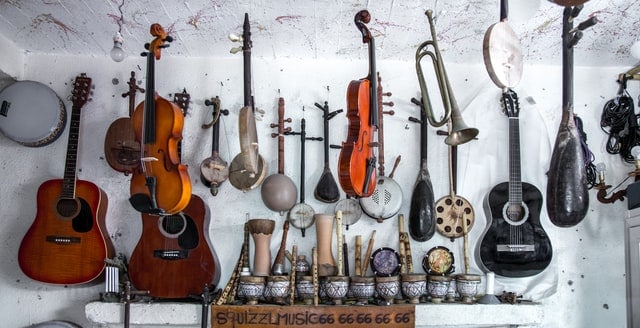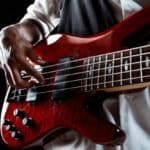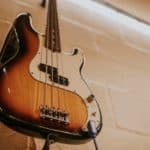When you think about guitars, you probably have a particular image that comes to your mind.
I’d bet it either is a solid-body electric or an acoustic guitar.
Unfortunately, it is not that I can read minds, it’s just that those 2 are the most popular kinds of guitars ever, and a cultural icon all around the world.
If you are on the journey of learning this amazing instrument, or perhaps just only curious about it, getting to know all the other different varieties there are might be useful.
Probably you have already made up your mind about what category of guitar really plucks your strings (pun intended), but perhaps you find out here about another class that grabs your interest.
In this article, I will give you a comprehensive list of all the types of guitars you could find in the wild. I will also characterize what music genres these are more commonly found in, and give you some sound samples and a list of players that use each of them.
Finally, I will answer some of the most frequently asked questions about this topic, and try to be as informative as possible.
After leaving this page, you will have a very complete understanding of all the sorts of guitars out there, how they sound, and what are their most common uses.
Are you ready to get started?
Let’s go!
Here are the 21 different types of guitars you need to know about:
1. Classical guitar
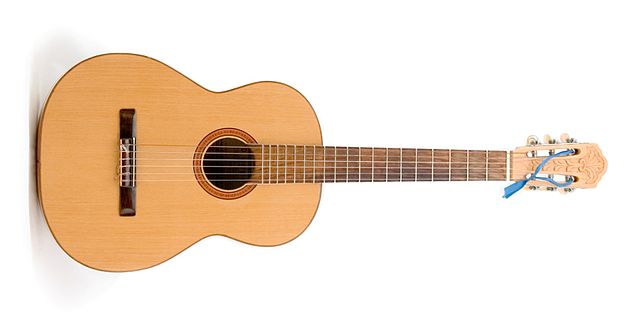
Classical guitars are the most traditional form of the instrument.
They are usually made of rosewood for the back and sides, cedar or spruce for the top, mahogany on the neck, and ebony fretboards.
Visually, they might resemble an acoustic guitar, but one of the most fundamental differences between them is that classical guitars use nylon strings.
What music genres can be played with a classical guitar
Classical guitars are widely used in classical and traditional music, although a lot of players also choose them to play folk, indie, and even pop.
Are classical guitars good for beginners?
More affordable classical guitars, those that are most likely to be a beginner’s first approach to the instruments, can be a bit hard on the fingers.
However, if you intend on playing this type of guitar long-term, there are no better alternatives possible.
How do classical guitars sound?
Classical guitars have a warm sound and are very resonant.
They are played as solo instruments in many pieces, so their tone can also be described as rich and full.
You can check out its sound here:
Players that use classical guitars
Some of the most popular classical guitar players ever, in no particular order, are:
- Andrés Segovia
- John Williams
- Pepe Romero
- Ana Vidović
- Francisco Tárrega
2. Acoustic guitar
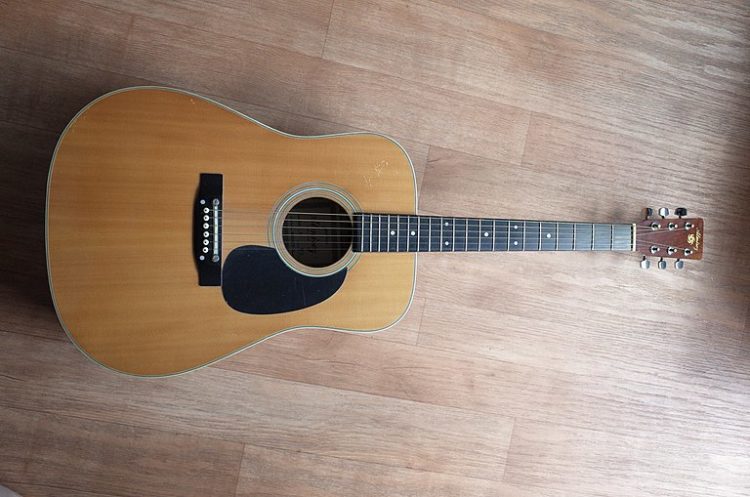
Acoustic guitars are probably the most common kind of guitar nowadays.
They look very much like classical guitars, however, the materials used to build them are more diverse, and they even come in many different body shapes.
These distinct body shapes are out of the scope of this article, but it is important to know that there are many, and an object of debate among players.
The most popular shape of an acoustic guitar is called dreadnought, one of the biggest, and hence loudest variations in which you might find them.
Every one of these aspects affects their sound and feel, but probably the most important feature is that they use steel strings.
What music genres can be played with an acoustic guitar
The acoustic guitar is one of the most used guitars across many different genres.
From rock to blues, to folk to pop, of course. You name it, and it probably has an acoustic on it.
The easiest way to define acoustic guitar-friendly genres is by the negative, and that’s pretty much any genre where guitars are heavily distorted like metal or hard rock.
Acoustics due to their increased resonance and acoustic loudness are not great at taking distortion.
Are acoustic guitars good for beginners?
Starting out with an acoustic guitar is what most guitar teachers recommend, and for good reasons.
Although cheaper acoustics can be a little bit rough on the fingers, you will get used to it in a few weeks.
Acoustics are easily available, simple, and just work.
You strum them and they make a sound.
So what could be better than that for a beginner?
How do acoustic guitars sound?
Acoustic guitars have a bright sound and can be really loud if played with energy.
They cut greatly through the mix, and even though most of the time are used as a rhythm instrument, they can be used for solo pieces too.
You can check out its sound here:
Players that use acoustic guitars
Some of the most popular acoustic guitar players ever, in no particular order, are:
- Tommy Emmanuel
- Django Reinhardt
- Andy McKee
- Paul Simon
- Chet Atkins
3. Electro-acoustic guitar
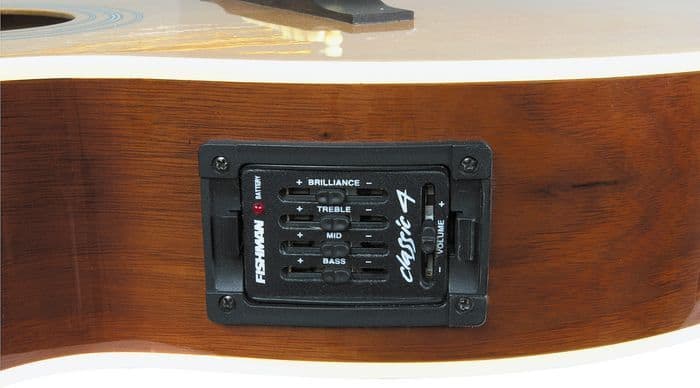
Electro-acoustic guitars might probably be included within the acoustic guitar category, however, I decided on separating both, since many people tend to get confused with them.
The main difference between these 2 classes is that electro-acoustic, as their name implies, apart from sounding acoustically like a regular acoustic, incorporates electronics that can pick up those vibrations and transform them into electrical signals which can be amplified.
If you want to dive deeper into the differences between acoustics and electro-acoustics, you should check out the following article:
What music genres can be played with an electro-acoustic guitar
Electro-acoustic guitars are used to play the same kinds of music as regular acoustic ones.
The only difference is that electro-acoustics have a built-in system that allows them to be amplified through loudspeakers.
So, think about stadium gigs, for instance.
Are electro-acoustic guitars good for beginners?
Electro-acoustic guitars play just like a regular acoustic, however, due to their added electronics, it’s possible that you could get a better regular acoustic for the same price.
However, nowadays electro-acoustics are so popular, and maybe are easier to find at lower price points.
They will work great for beginners whichever way.
How do electro-acoustic guitars sound?
The sound of an electro-acoustic guitar when played without amplification will be indistinguishable from a regular acoustic.
Amplified electro-acoustics have a flatter and bright sound since some of the acoustic richness is lost when the signal is electrified.
Pickups are the device responsible for doing so, and they come in many different varieties.
You can check out the most popular ones in this article:
You can check out its sound here:
Players that use electro-acoustic guitars
Some of the most popular electro-acoustic guitar players ever, in no particular order, are:
- Ed Sheeran
- Bob Dylan
- Taylor Swift
- Paul Simon
- Bruce Springsteen
4. Electric guitar

The electric guitar is the cornerstone of most modern music genres.
In the 30s, having a guitar that could be even heard among the strident sound of big band orchestras started being a necessity.
Until then, the only alternative was relying on acoustic sound and what a traditional microphone can get, soloing was not an alternative.
This led to the invention of the modern electric guitar pickups, which rely on magnets to pick up the string vibrations and transform them into electrical signals.
The first electric guitar was just a regular acoustic jazz archtop with a pickup attached to them.
By definition, any guitar with an electric pickup can be called an electric guitar.
However, and for specificity purposes, in this article you will find many different kinds of electric guitars as their own categories, starting with the electro-acoustics above.
What music genres can be played with an electric guitar
Along with acoustic guitars, electric guitars are probably up there in terms of versatility.
You can play almost any genre with an electric, but of course, there are sounds that are out of their reach.
For instance, you shouldn’t expect it to sound like an acoustic or a classical guitar.
To name a few, many players pick electric to play rock, hard rock, metal, blues, jazz, country, and the list goes on.
Are electric guitars good for beginners?
Contrary to the opinion of many more traditional players, I think electric guitars are great for beginners since they are easier on the fingers. They require less force to be fretted.
On the flip side, electric guitars require a cord and amp to produce any of their intended sounds, so that adds to the initial budget and the ground level of complexity necessary to just start playing.
How do electric guitars sound?
Electric guitars can be aggressive and mellow. There are unlimited tones within most electrics, although some are truly more versatile than others.
From warm dark sounds that most jazz players use to heavy metal riffs, to bright country licks, electrics will have you covered.
You can check out their sound here:
Players that use electric guitars
Some of the most popular electric guitar players ever, in no particular order, are:
- Slash
- Angus Young
- John Mayer
- Larry Carlton
- Jimi Hendrix
5. Solid-body electric guitar
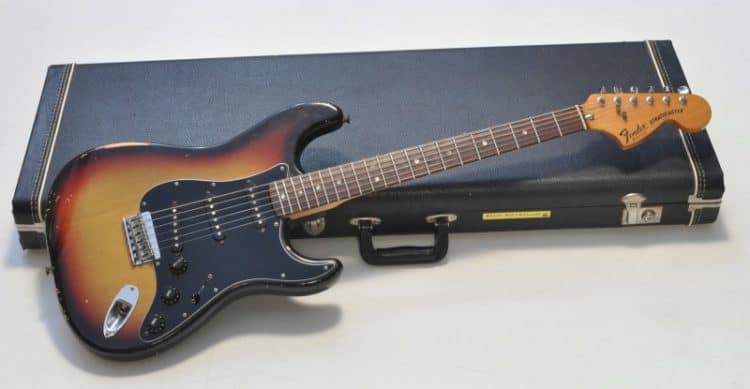
Solid-body electric guitars are probably what you think of when you imagine an electric guitar.
Stratocasters, and vintage Les Pauls, for instance, are solid-body.
And, as straightforward as it sounds, this denomination refers to their bodies consisting of solid woods, which can be several slabs or composed of different layers.
This is a completely different approach to the classic guitar designs that relied on acoustics.
Since solid-body electrics are intended to be amplified, their sound comes from the pickups getting the string vibrations, and they don’t need big resonance chambers such as acoustic guitars do, for instance.
Solid-body electrics, when unplugged, have a very quiet acoustic sound because they are not intended to be played that way.
What music genres can be played with a solid-body electric guitar
Solid-body electric guitars are great for genres that require a bit (or a lot) of distortion because not having a resonance chamber reduces their feedback greatly.
So think of rock, hard rock, metal, punk, grunge, etc.
But, as popular as they are, don’t disregard any other genre. Many players use solid-body electrics to play almost any musical genre you could imagine.
Are solid-body electric guitars good for beginners?
Solid-body electric guitars are great for beginners that really intend on playing the electric guitar long-term.
They are the simplest alternative, and one of the most versatile ones.
How do solid-body electric guitars sound?
Solid-body electrics have a bright sound, clean up nicely, and can take extreme amounts of distortion if needed.
You can check out their sound here:
Players that use solid-body electric guitars
Some of the most popular solid-body electric guitar players ever, in no particular order, are:
- David Gilmour
- John Mayer
- Jimi Hendrix
- Slash
- Joe Satriani
6. Weight-relieved electric guitar

Weight-relieved electric guitars are pretty much the same as solid bodies, with the difference that they have some material removed from their inside with the sole purpose of making them lighter.
This is an important feature since weight is something a lot of players pay a lot of attention to, especially on bigger body models.
The thing is, some people claim that the resulting holes inside of these guitar bodies have an impact on their sound.
Of course, not as drastic as with a completely hollow or chambered instrument, but still significant to certain players.
Gibson was the main brand that popularized this concept, and their weight relief methods have shifted through the years.
Here is an article where you can learn more about this:
What music genres can be played with a weight-relieved electric guitar
Since weight-relieved electric guitars are a small subgenre of solid-body electric guitars, they will work as well for any music style where these shine.
Think of rock, hard rock, metal, but also country, blues, pop, and many others.
Are weight-relieved electric guitars good for beginners?
Probably weight-relieved electric guitars are not the greatest choice for a beginner, since most models in this category are rather expensive.
How do weight-relieved electric guitars sound?
Weight-relieved electric guitars, in most cases, sound just like solid-body electric guitars. With the exception of the most extreme instances of weight relief, where lots of players claim to hear a difference.
You can check out their sound here:
Players that use weight-relieved electric guitars
It’s really hard to name famous particular players who only use weight-relieved guitars. But anybody using Les Paul Standards from 1983 to 2019 could make this list.
7. Semi-hollow/Hollow body electric guitar
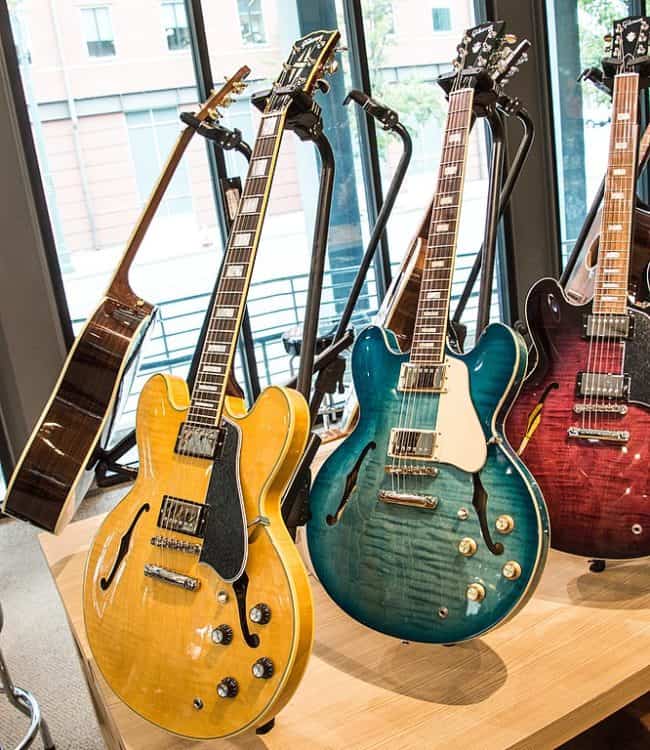
Semi-hollow and hollow body instruments are other common subtypes of electric guitar.
As their name implies, these are chambered guitars with electric pickups.
They come in many shapes and different designs, many brands specialize in them and are usually more expensive instruments due to the higher level of craftsmanship required to build them.
The main difference between these 2 is that while hollow body guitars are completely hollow, and all the hardware is installed on their top, semi-hollows have a central piece of solid wood to mount it.
This last one is a more modern design and was popularized by Gibson.
What music genres can be played with a semi-hollow/hollow body guitar
Semi-hollow and hollow-body electric guitars really shine on American traditional genres such as blues, jazz, vintage rock, and rockabilly.
Although, you can also find them in the hands of more modern indie rock players that dig them for their unique sounds and looks.
Are semi-hollow/hollow body guitars good for beginners?
Semi-hollow and hollow-body electric guitars might not be the best choice for beginners unless they really intend on playing the music styles where these instruments shine.
They are usually bigger, and although lighter, their shapes can be uncomfortable for newer players.
Also, they are more prone to feedback, so this could be a problem if you intend on playing with lots of distortion.
How do semi-hollow/hollow body guitars sound?
Semi-hollow and hollow electric guitars have a particularly warm sound. Their tone can be perceived as thinner by some players, although they have enough body and punch to power through almost anything.
Larry Carlton went as far as to say that the Gibson 335 is the most versatile guitar ever.
You can check out their sound here:
Players that use semi-hollow/hollow body guitars
Some of the most popular semi-hollow/hollow electric guitar players ever, in no particular order, are:
- Larry Carlton
- Jack White
- Brian Setzer
- Noel Gallagher
- B.B. King
8. Archtop guitar

Archtop guitars are a kind of hollow body acoustic instrument, not necessarily electric.
Their name comes from how their body is constructed since they have an arched carved top whose shape is held by ribs inside the resonance chamber.
Archtops naturally have a big acoustic sound and are one of the oldest, if not the oldest, kinds of modern guitar.
Due to their complexity and specialty, these are also rather expensive instruments, and probably their sound is not for everyone.
What music genres can be played with an archtop guitar
Archtop guitars, without a spec of doubt, are guitars that you will find mostly in the hands of jazz, blues, and rockabilly players.
Their specific tone makes them very desirable for playing genres such as these.
Are archtop guitars good for beginners?
Archtop guitars are not the first thing that comes to my mind when I think about a beginner’s guitar.
They are expensive, rather big and uncomfortable, and a bit genre-specific.
All of this makes me think there are better alternatives for beginners.
How do archtop guitars sound?
Archtop guitars have a particular dark, but a warm and rich acoustic tone that’s very unique to them, and that you could only hear at their full potential if you ever happen to be in a room with them.
You can check out their sound here:
Players that use archtop guitars
Some of the most popular archtop guitar players ever, in no particular order, are:
- Joe Pass
- Wes Montgomery
- Herb Ellis
- Jim Hall
- Tal Farlow
9. Resonator guitar
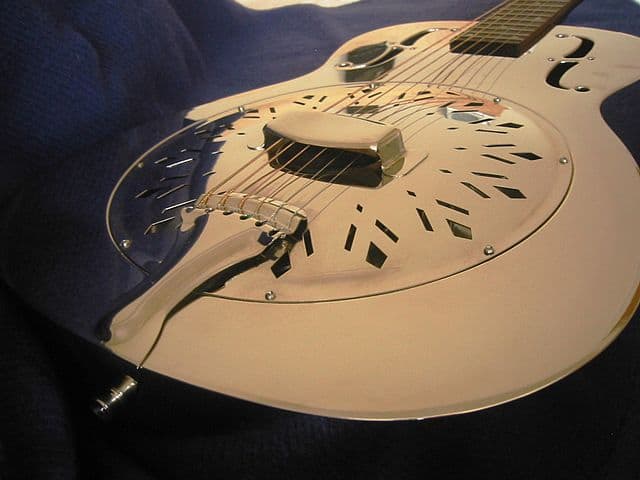
Resonator guitars are acoustic guitars designed to drive the vibrations of their strings to spun metal cones, called resonators.
These instruments are known for incorporating metal into the guitar body, which is a material, not that commonly used on any other type of guitar.
The reason for their existence is similar to many others on their list. Their design was a quest to get more volume and to avoid the guitar being overwhelmed by the horn section of a big band.
Many players nowadays swear by these guitars, and many play them with slides.
Resonator guitars have a very particular sound and are a staple for genres such as blues.
Finally, some people also refer to these as Dobros, however, Dobros are just a kind of resonator guitar.
What music genres can be played with a resonator guitar
Resonator guitars are extremely popular, and almost exclusively used to play bluegrass and blues.
They are a tradition for many styles of these genres and a fundamental part of southern American culture.
Are resonator guitars good for beginners?
I don’t think resonator guitars are a good instrument for beginners unless they want to play this type of guitar long-term.
Their bright and strident sound is not for everyone, and playing them with a slide is not mandatory, but very common.
Probably a regular acoustic guitar will suit a beginner better.
How do resonator guitars sound?
Resonator guitars sound bright, metallic, and in your face. They are played with metal or glass slides most of the time, which gives them very organic, loud, and vocal-like inflections.
You can check out their sound here:
Players that use resonator guitars
Some of the most popular resonator guitar players ever, in no particular order, are:
- Duane Allman
- Josh Graves
- Jerry Douglas
- Rob Ickes
- Andy Hall
10. 12-string guitar
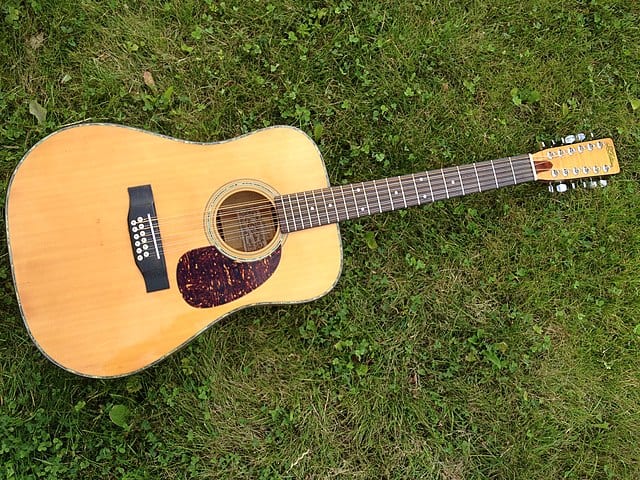
The 12-string guitar is commonly found in its acoustic guitar version, but there are also many manufacturers that spun it off as an electric.
As the name suggests, these guitars just have twice the strings as any regular one.
But the catch is that the extra strings just double the regular 6 on a guitar.
For the higher strings, the partnering extra string is tuned exactly the same, giving a charming unison sound, while for the lower strings, companion strings are tuned an octave higher.
12-string guitars have a full sound that’s preferred by many players for strumming parts.
What music genres can be played with a 12-string guitar
12-string guitars will work almost anywhere where a regular guitar fits in.
You will commonly hear them in rock ballads, pop, country, and folk, among many other genres.
Are 12-string guitars good for beginners?
12-string guitars are probably too complex for complete beginners. Although they are played in a very straightforward fashion, the added complexity of having double strings can be overwhelming.
How do 12-string guitars sound?
In my head, 12-string guitars have a sound that reminds me of an upright piano, but maybe that’s just me.
12-strings sound as if they had a built-in chorus effect, probably because they do.
They will sound to the untrained ear as a richer fuller regular acoustic.
You can check out their sound here:
Players that use 12-string guitars
Some of the most popular 12-string guitar players ever, in no particular order, are:
- Roger McGuinn
- Leo Kottke
- Tom Petty
- George Harrison
- Pete Seeger
11. 7/8/9-string (extended-range) guitar
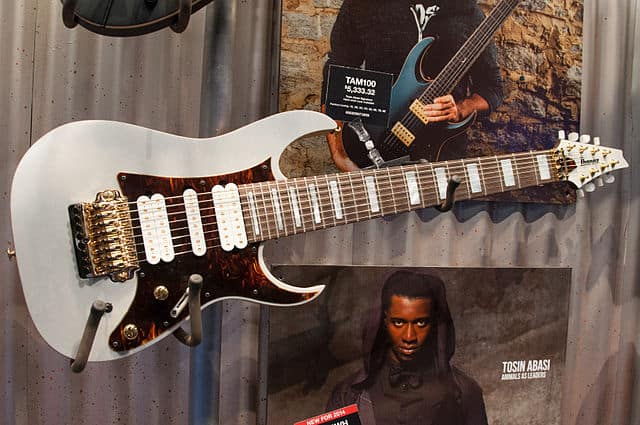
Extended range guitars, which is not a name commonly used to refer to them have been around for longer than you may think.
They were rather common as classical or archtop guitars.
However, their newfound popularity undoubtedly comes from a lot of metal players thirsting for deeper and heavier sounds.
Their name refers to the extra notes you get by simply adding more strings, thus extending their range, in terms of available pitches.
This extended range comes in the low register, and that’s why many solo classical and jazz players adopted 7-string guitars, for instance, because they could play deeper bass lines by themselves.
Extended range guitars have wider necks to accommodate the extra string(s), and in some cases fanned frets to maintain a proper intonation across all their different-sized strings.
What music genres can be played with an extended-range guitar
Extended range guitars can be used for a wide variety of genres. Actually, anything you can play with a regular guitar, you could also play with extra strings.
However, most players that choose this kind of guitar usually take advantage of the lower register limit, so that’s why they are so popular among metal players.
But also is not uncommon to find classical, jazz, and blues players that enjoy the ability to be their own bass players.
Are extended-range guitars good for beginners?
Extended-range guitars might not be the best choice for a complete beginner, for the simple fact that they just add more complexity. Extra strings can be overwhelming.
Their necks and bigger, and for younger players with smaller hands it might be a bit uncomfortable.
How do extended-range guitars sound?
Extended range guitars sound exactly like regular ones in their normal register, but get into baritone or even bass guitar territories on their lower strings. It’s like having the best of both worlds.
You can check out their sound here:
Players that use extended-range guitars
Some of the most popular extended range guitar players ever, in no particular order, are:
- John Petrucci
- Tosin Abasi
- Misha Mansoor
- Devin Townsend
- Charlie Hunter
12. Baritone guitar
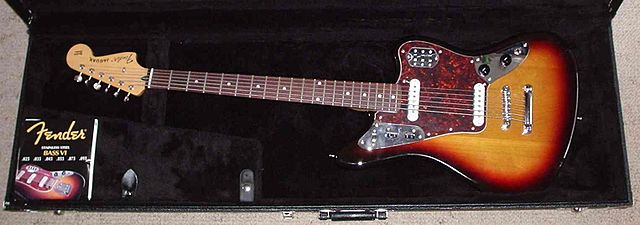
Baritone guitars are the middle point between a guitar and a bass.
They are usually bigger, have longer scales, and thicker strings to allow them to be tuned lower than a regular guitar without any issues.
The standard guitar tuning is EADGBE, but baritones are usually tuned a fourth lower in BEADF#B.
You can, of course, find them tuned in many other different ways, but their main function is to provide a deeper guitar voice in the mix.
Think of a baritone singer and a tenor singer. While a big part of the notes they have available overlap, the specialty of the former is the lower notes that are only available to him.
What music genres can be played with a baritone guitar
Baritones are rather versatile, and you can find them among many different genres.
They were very popular for surf rock, but you can also hear them in stoner rock, hard rock, metal, and indie music styles.
Are baritone guitars good for beginners?
Baritones can work for a beginner since they feel pretty much like a regular guitar, however, I can think of a really good reason to recommend them, anyway.
It will be easier to start with a regular guitar, strings are easier to get, and you will have a lot more tabs and resources to learn from.
How do baritone guitars sound?
You can think of baritones as a step between a guitar and a bass guitar. They have the snap and brightness of guitar pickups, but provide access to lower pitches, allowing for some deep rich sounds.
You can check out their sound here:
Players that use baritone guitars
Some of the most popular baritone guitar players ever, in no particular order, are:
- Duane Eddy
- Pat Metheny
- Ian McKaye
- Ben Burnley
- Don Ross
13. Electric bass guitar
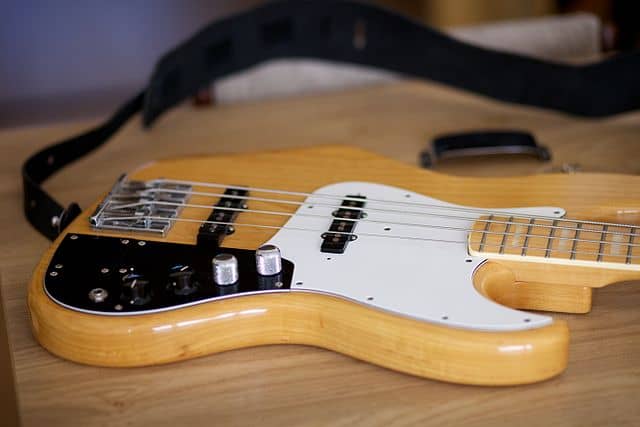
Although it sounds counterintuitive the electric bass was invented some 20 years after the electric guitar.
The thing is, the necessity wasn’t as pressing as with the guitar.
Most bands back then used gigantic double basses that relied on their size to push enough air to be heard over the rest of the instruments.
And, although inconvenient for many players, it worked like a charm.
In the early 50s Leo Fender tried out his concept for an electric bass and it was incredibly well received among musicians.
The instrument was earlier conceptualized and prototyped in the 30s, but it wasn’t until Fender’s take that it became popular.
Although the sound of the electric bass is notably different from the double bass, it has taken its role in many bands and styles since its invention, leaving its parent instrument as a niche alternative.
Electric bass guitars usually have 4 strings, are lighter, smaller (although bigger and with a longer scale than a regular guitar), and also have frets, something that double basses lacked.
All these features made them a very enticing alternative for players since they are more convenient and easier to pick up.
What music genres can be played with an electric bass guitar
The question should be “what music genres” you can’t play with a bass guitar.
Since they were conceived, they took over the player base, and you will find an electric bass in almost every popular genre, even in jazz.
Although some bass players still rock their double basses, electric bass guitars have proven to be more convenient and easier to gig with.
Are electric bass guitars good for beginners?
Electric bass guitars are great for beginners. Of course, this is true only if you intend on being a bass player. If you are thinking of getting a bass guitar just to jump into the regular guitar bandwagon down the line, then no, just go get a guitar.
Although the mechanics are almost the same, the playing technique, the role in the band, and what you actually play with a bass guitar is unique to it, and although some can carry over to the “normal” guitar, it would not be the most efficient way of approaching it.
How do electric bass guitars sound?
Electric bass guitars sound deep and can be either bright and aggressive or mellow and dark. They are a whole world in themselves, and you will find many different brands, models, and designs that ultimately define their tone.
You can check out their sound here:
Players that use electric bass guitars
Some of the most popular bass guitar players ever, in no particular order, are:
- Marcus Miller
- Victor Wooten
- Flea
- Jaco Pastorius
- Pino Palladino
14. Acoustic bass guitar
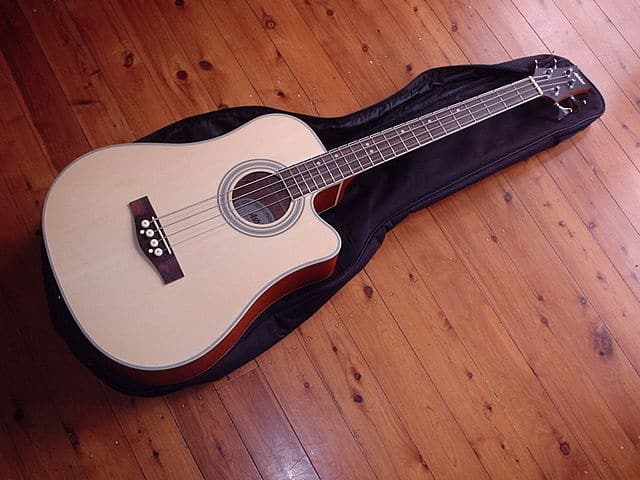
Acoustic bass guitars were introduced in the 1910s but they didn’t get any actual traction until the electric bass guitar was really popular.
Following the same concept as a regular acoustic guitar, acoustic basses are bigger and longer scale than them.
They also have 4 strings as their electric counterparts.
The issue with acoustic basses, however, is that they are rarely loud enough to be completely usable.
You can read more about this in this article:
But in short, apart from unplugged sets, they are rarely used, since even with most of them incorporating electric pickups, the sound of actual electric bass guitars tends to be favored by most musicians.
There is however a place for acoustic bass guitars and many musicians have them in their arsenal.
What music genres can be played with an acoustic bass guitar
Acoustic bass guitars are quite limited since their sound doesn’t add that much to the equation, and a regular electric bass guitar will do the job as good or better.
Commonly acoustic bass guitars are relegated to unplugged sets where there’s no chance of going through a PA or some sort of amplification.
Are acoustic bass guitars good for beginners?
If you intend on being a bass player, I can see how an acoustic bass could be a convenient instrument to start with.
You won’t need an amp or cable, and you can just start playing right away.
So, yes, acoustic bass guitars could work for beginners, but there’s always the question about how long it will take for you to want to play with other people and find out that you really need an electric bass.
How do acoustic bass guitars sound?
Acoustic bass guitars due to their reduced size, in comparison with double bass, are not that loud. You will obviously hear them clearly in a room, but if things get noisy, they might fall short.
In terms of character, they sound a bit brighter and more resonant than an electric bass, and also they have a more percussive sound since they naturally project how hard the player is pushing them.
You can check out their sound here:
Players that use acoustic bass guitars
It’s really hard to name famous particular players who only use acoustic bass guitars. But I’m pretty sure most famous bass players do have an acoustic bass guitar in their arsenal.
15. Lap-steel guitar
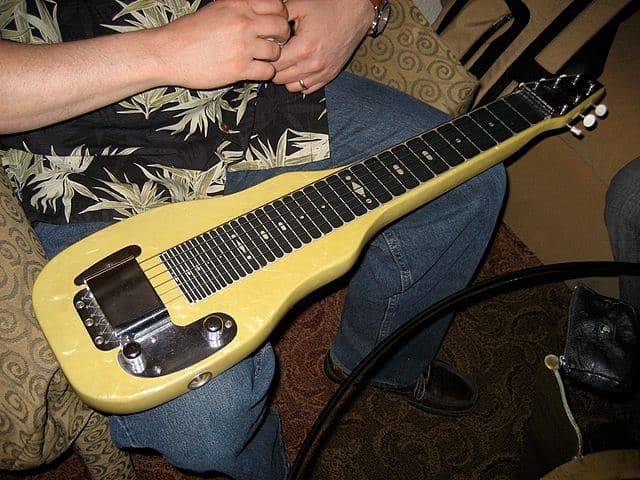
The lap-steel guitar is an instrument that’s commonly played horizontally over the legs of the player by pressing a steel bar over the strings and plucking them, hence its name.
Lap-steels don’t have frets but have markers so the players don’t get lost along their fretboard.
This instrument is also known as the “Hawaiian guitar”, and can be found in purely acoustic and electric versions.
It has a very warm tone, and their slide playing makes it sound very vocal-like and great for soloing.
What music genres can be played with a lap-steel guitar
Lap-steels are very popular in country music, however, you can also hear them in blues, pop, and some rock subgenres.
Their function in the band varies, while in some songs they take a more central role, in other compositions they can work just as a melodic instrument playing simple lines.
Are lap-steel guitars good for beginners?
If you want to play lap-steel guitar, there are not many alternatives to it. A lot of lap-steel players started with this kind of guitar and never learned how to play a more traditional one, and that’s fine.
Really, you can think of lap-steel as their own unique instrument that borrowed a lot from guitar, but that’s played radically differently.
How do lap-steel guitars sound?
Lap-steels have a very warm and vocal sound due to being played with a steel slide. Their lines have a human-like inflection and the instrument overall has a very rich tone.
You can check out their sound here:
Players that use lap-steel guitars
Some of the most popular lap-steel guitar players ever, in no particular order, are:
- Sol Hoopii
- Bob Dunn
- Jerry Byrd
- Don Helms
- Bud Isaacs
16. Pedal-steel guitar
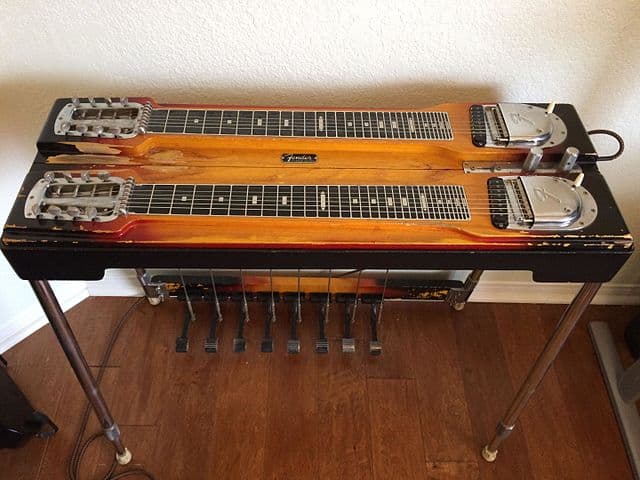
The pedal-steel guitar is another type of “steel” guitar, meaning that it’s played with a steel bar pressed against the strings that are plucked.
It’s a more complex take on the lap-steel if you accept the comparison.
Pedal-steels have pedals and knee levers that allow the players to shift the pitches of certain strings, allowing for sounds that can’t be achieved with any other steel guitars.
This functionality is commonly used to play what’s known as double stops, where some notes on a chord bend until they reach their intended pitch.
They are unique and require some specialization, but their sound is charming and many players still gravitate towards them nowadays.
What music genres can be played with a pedal-steel guitar
Pedal-steel guitars, similarly to lap-steels, are very common in country, blues, rock, and even pop.
You can hear them taking a very central role in more traditional genres and more of an auxiliary support arrangement function in more modern ones.
Are pedal-steel guitars good for beginners?
Due to the similarity with lap-steel guitars, I think for beginners the latter could be an easier way to step in and not worry about any pedals or complicated contraptions.
However, if you are very keen on learning the pedal-steel, and you are willing to cope with having to also use your feet at some point, by all means, go for it.
There’s no point in learning the acoustic or electric guitar first since pedal-steels are played in a completely different way.
How do pedal-steel guitars sound?
Pedal-steel guitars sound very human and warm. The fact of being played with a steel bar allows the player to approach pitches in a very natural way.
You can check out their sound here:
Players that use pedal-steel guitars
Some of the most popular pedal-steel guitar players ever, in no particular order, are:
- Bud Isaacs
- Steve Howe
- Toy Caldwell
- Leo LeBlanc
- Jeff Newman
17. Folk guitars
This list wouldn’t be complete if we omitted the different guitars of the world.
Many of these instruments inspired what we now know as the modern guitar, but for practical purposes, we can also consider them as types of guitars.
Of course, there are and have been hundreds if not thousands of guitar precursors around the globe, but here are some of the most popular ones:
Ukelele
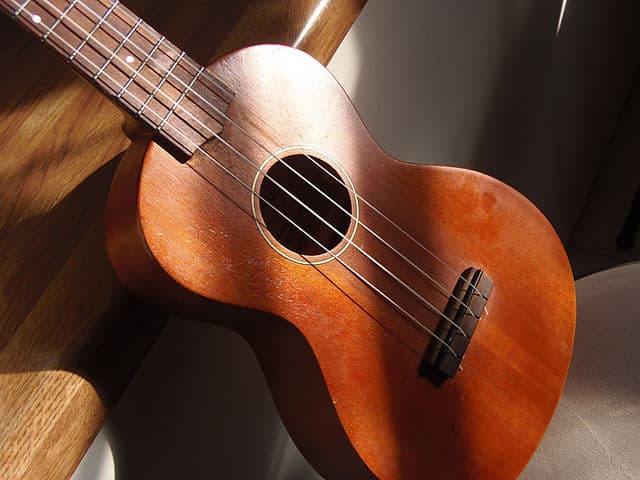
The ukelele contrary to what many may think has Portuguese origins, however, it was popularized in Hawaii.
Ukes look like small guitars, have 4 nylon strings, and come in 4 sizes: Soprano, concert, tenor, and baritone.
Banjo

The banjo occupies a central place in Black American traditional music. They are comprised of 4 or 5 strings attached to a resonator membrane, that’s fixated to a metal frame.
Banjos are a staple of country music, but also very common among many different folk genres, and even more modern takes such as jazz, blues, and rock.
Mandolin
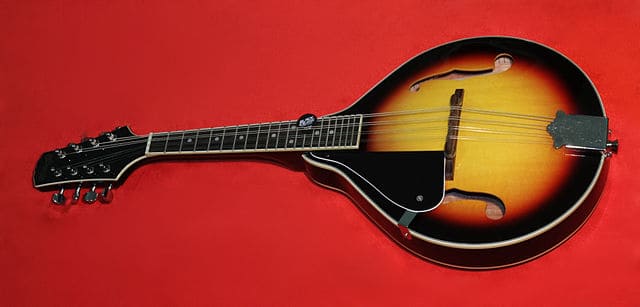
The mandolin is a European stringed instrument, popularized in Italy that consists of 4 courses of doubled metal strings tuned in unison. It’s usually plucked with a plectrum, and very commonly played using a tremolo technique.
Mandolins are a rather popular instrument nowadays and are frequently featured in film scores, and folk songs.
Cuatro

The cuatro is a Latin American string instrument that is derived from the Spanish guitar. It has 4 nylon strings and is similar in shape and tuning to the Ukelele, however, there are many different versions of it that vary among countries.
Some Cuatros can even have double or triple-coursed strings as mandolins.
Cuatros can be heard in Latin music and have a warm welcoming sound.
Balalaika

The balalaika is a Russian instrument with a triangular body shape. It has 3 strings, 2 of which are usually tuned in unison while the third is tuned to a perfect fourth higher.
Balalaikas come in different sizes and are usually tuned depending on the pieces of music they are intended to be used to play.
They can be heard mostly in Russian folk music.
Guitarrón

The guitarrón is a Mexican instrument, but there are also instruments with the same name from Chile and Argentina. This convergence in the name is because “guitarrón” means “big guitar” in Spanish.
Guitarrones are very large and have deep bodies, have 6 guitars, and take the role of a bass instrument.
Its dimensions allow for the loudness needed to be heard among other instruments in Mariachi groups.
Sitar
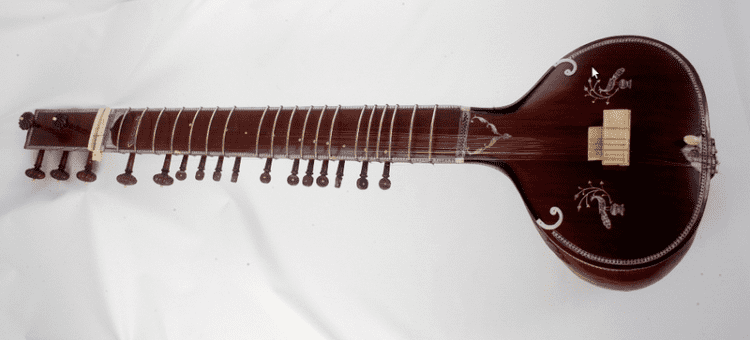
The sitar is an Indian plucked string instrument with 18 to 21 strings, of which 6 or 7 usually run curved.
Sitars are tuned to Hindustani musical standard tunings and can be heard in traditional and classical music from these countries.
You can commonly hear them in western music also and were probably popularized by the Beatles on this side of the world.
Bouzouki
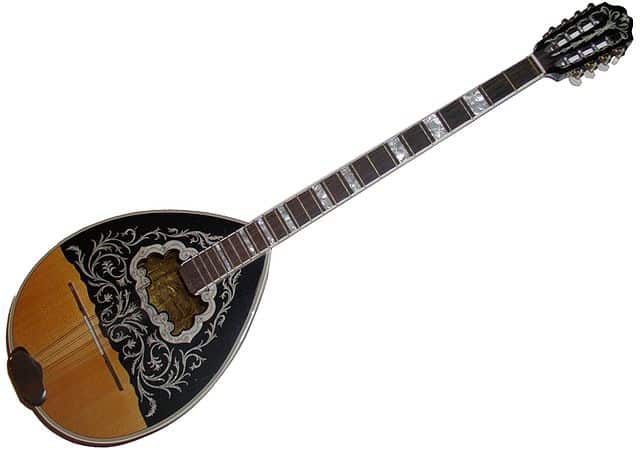
The bouzouki is a stringed instrument from Greece. It has a long neck and a flat top. Its 3 or 3 pairs of strings are plucked with a plectrum, and it’s tuned lower than a mandolin.
Bouzoukis were introduced in the early 1900 and have been a central part of traditional and popular Greek music since then.
Cigar-box guitar

The cigar-box guitar, as its name implies is a type of guitar constructed using a cigar box as its resonator and body. It usually has 1 to 3 strings, although there are no formal design specifications for it.
Cigar-box guitars are fun instruments, usually played in bluegrass, country, and blues tunes.
Charango
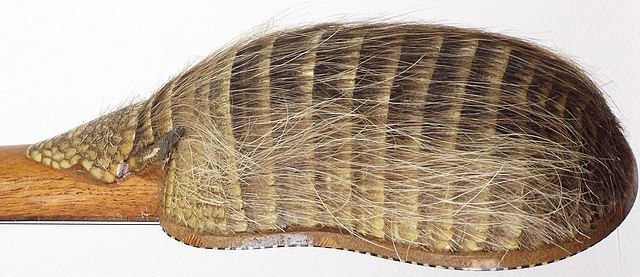
The Charango is a Latin American type of small guitar, rather common in Ecuador, Perú, Bolivia, and northern Argentina. Although there are many variations, traditionally it was made using the shell from the back of an armadillo.
Charangos have five courses of 2 strings and are habitually used as rhythm instruments to play chords.
Cavaquinho

The Cavaquinho is a small Portuguese instrument that has 4 strings. It has many forms, and the Brazilian is one of the most popular. It resembles a small classical guitar and also is pretty similar to a Cuatro.
Cavaquinhos are a big part of traditional Brazilian music, and of the music from other former Portuguese colonies.
Lyre-guitar
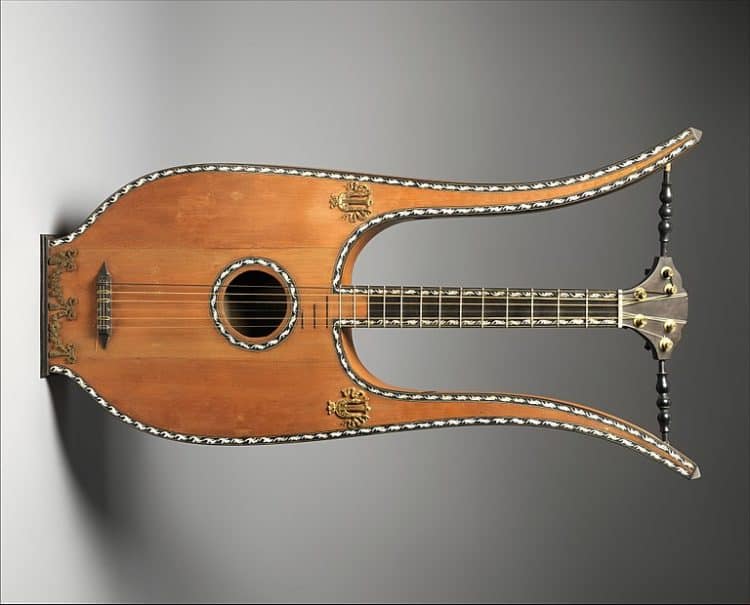
The Lyre-guitar was popularized in Europe in the 1800s. Its design resembles the shape of an ancient lyre with 2 wings that span on the sides of the fretboard. It has 6 six strings, and it’s tuned like a regular guitar.
Lyre-guitars were very popular during the mentioned period in France and were seen as fancy salon instruments, however, with time, regular guitars took over.
Bordonúa

The Bordonúa is a big string instrument original from Puerto Rico that takes the function of a bass. It has 3 sound holes and has variants with 6 single strings, and 8 and 10 strings in pairs of 2, being the 10-string version the most common.
Bordonúas are typically played in Puerto Rican folk orchestras alongside cuatros.
Cuban Tres
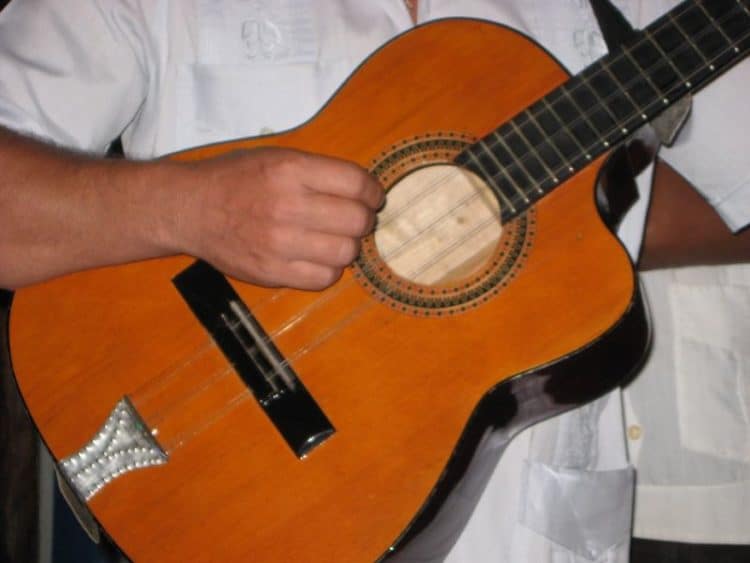
The Cuban Tres is an instrument inspired by the Spanish guitar, but smaller in size and scale. It traditionally has 3 courses of double strings that are tuned in octaves (low course) and in unison (middle and top course).
Cuban Treses are a staple of Cuban music and a fundamental piece of the Cuban Son, one of the most popular music genres on the island.
Dutar

The Dutar is a traditional string instrument from Iran and Central Asia. It has a characteristic long neck and only 2 strings which originally were made from guts, later from silk brought from China, and nowadays are nylon, as with many other instruments.
Dutars have a deep tradition within the region, and even the way they are played is known to vary between communities and ethnicities.
Kobza
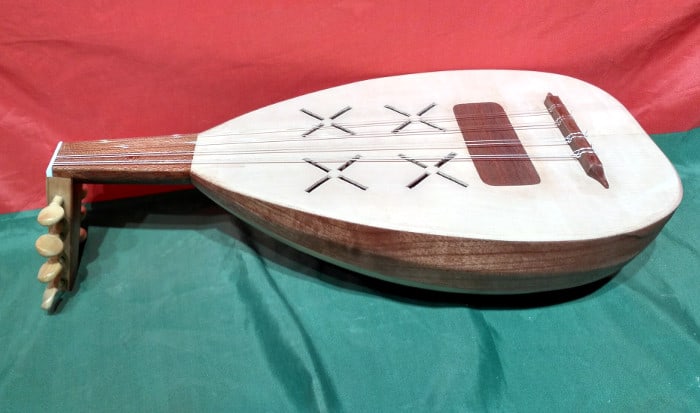
The Kobza is a Ukrainian folk instrument with a characteristical break angle for its headstock. It’s traditionally single-strung, and nowadays there are 2 most popular versions:
The orchestral fretless Kobza has 4 strings and is tuned in fifths, and the accompaniment Kobza, which usually has 6 or 7 strings, has frets and is tuned as a regular guitar.
Kobzas are a part of Ukrainian culture and can be heard in many traditional folk tunes.
18. Multi-neck guitar
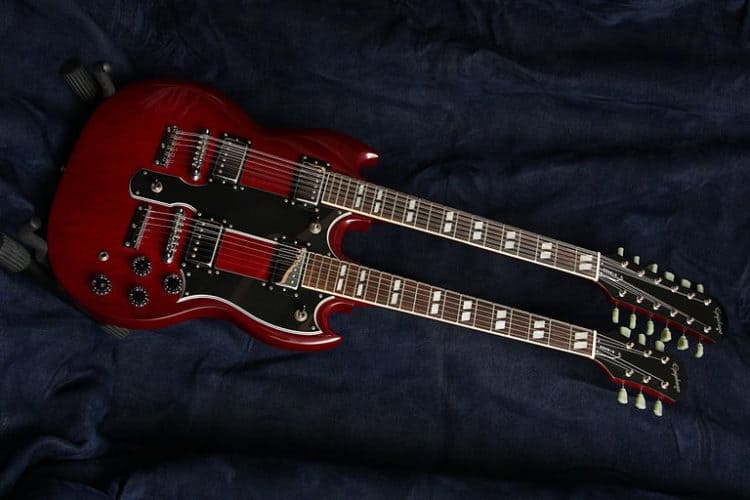
Multi-neck guitars can look overwhelming to the untrained eye, but let’s break down the myth: They are just many guitars in one.
The next time you see your favorite player rocking one of these, pay close attention. You might figure out that usually one of the necks is a regular 6-string, while the other is a 12-string, and the other is a bass guitar.
Of course, you can go wild with the different configurations, but mostly their function is that.
Also, you could find cases where the extra necks are not different kinds of guitars, but guitars tuned differently.
They are more of a party trick rather than an actual instrument, although for some bands and songs they are the only way of playing complex parts that incorporate many different kinds of guitars.
What music genres can be played with a multi-neck guitar
With a multi-neck guitar, you can play just about anything that you could with a single-neck guitar.
The advantage of having multiple necks is having the ability to switch from one kind of guitar to another on the spot.
For instance, having a 12-string neck to play rhythm, and a regular 6-string to do solos.
Are multi-neck guitars good for beginners?
Multi-neck guitars are absolutely not suited for beginners. They are a tool for the gigging musician, and even for the top 1% of most extreme showmen.
Stick to regular, individual types of guitar, and then, if at some point in your journey you need to perform with many of them at the time, you could give them a try.
How do multi-neck guitars sound?
Multi-neck guitars sound just like what their individual necks do. They are simply many guitars glued together or sharing the same body.
They normally have individual outputs for each one of their guitars.
You can check out their sound here:
Players that use multi-neck guitars
Some of the most popular multi-neck guitar players ever, in no particular order, are:
- Steve Vai
- Jimmy Page
- John McLaughlin
- Rick Nielsen
- Rik Emmett
19. Travel guitar

Travel guitars are a broad kind of guitar, but what all of these instruments have in common is that they allow for easy transportation.
You can find them with reduced size body shapes, or even no guitar body at all, with foldable contraptions, or any other ways of reducing their cubic volume and their convenience.
Of course, for travel guitars, having a good tone is an afterthought, although producing some kind of guitaristic sound is mandatory.
Their main function is to be easy to pack and carry around everywhere you go, to accompany yourself, or to throw a quick practice session on the road.
These guitars are just fun and convenient, and you can find many different iterations of this concept out there.
What music genres can be played with a travel guitar
Travel guitars are mostly designed for strumming and maybe practicing some lines when there’s no proper gear available.
You can play the same you would on a regular acoustic guitar, although it won’t sound as great.
Are travel guitars good for beginners?
Beginners can indeed take on travel guitars, and be benefited from their portability. However, in terms of sound, they will surely be underwhelmed.
Travel guitars tend to be smaller, and in some cases of shorter scales, favoring smaller hands, so this is a thing to consider.
How do travel guitars sound?
Travel guitars don’t sound that great, honestly. But delivering a great tone is not their goal. They’re all about portability and availability, even when the outcome of playing them can be perceived as weak and muffled.
You can check out their sound here:
Players that use travel guitars
It’s really hard to name famous particular players who use travel guitars. Probably a lot of well-known guitarists have travel guitars to stay in shape while touring.
20. Harp guitar
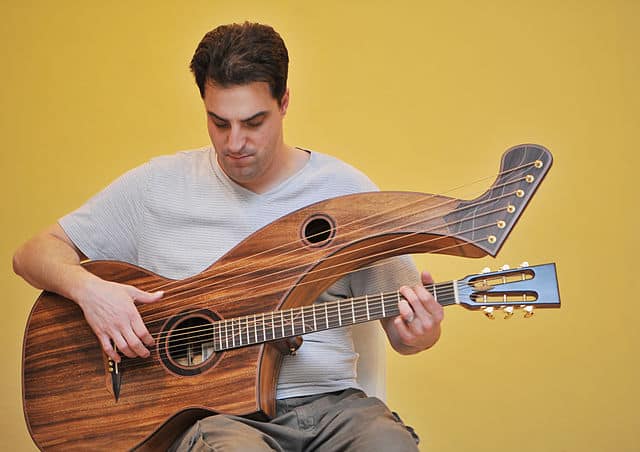
Harp guitars are commonly a subcategory of acoustic guitars, although I’m sure somebody has tried this concept with an electric.
Apart from traditional guitar strings ordered horizontally and played by fretting and plucking, these incorporate strings without frets in an oblique fashion that are intended to be played as a harp, and most commonly are tuned to low pitches.
However, you can also find harp guitars with harp strings tuned to a certain chord or scale in higher registries.
The concept is straightforward, but in practice, a very complex instrument to master and create music with.
This kind of guitar is really something to see and hear.
What music genres can be played with a harp guitar
Harp guitars are commonly used to play their own original pieces. The instrument is an experience in itself.
But, I think they could work for folk and any other genres that rely on the sound of an acoustic guitar.
Are harp guitars good for beginners?
In no way harp guitars would be suitable for beginners, they are expensive and confusing to play properly.
Not to mention their usually bigger body shape which can be uncomfortable for most players.
How do harp guitars sound?
Harp guitars sound just as regular acoustic ones, but with the ability to play some low notes on the harp strings, or even preset complete chords if they have these kinds of harps in them.
You can check out their sound here:
Players that use harp guitars
Some of the most popular harp guitar players ever, in no particular order, are:
- Andy McKee
- Don Alder
- Antoine Dufour
- David Lindley
- Matt Thomas
21. Synth guitar
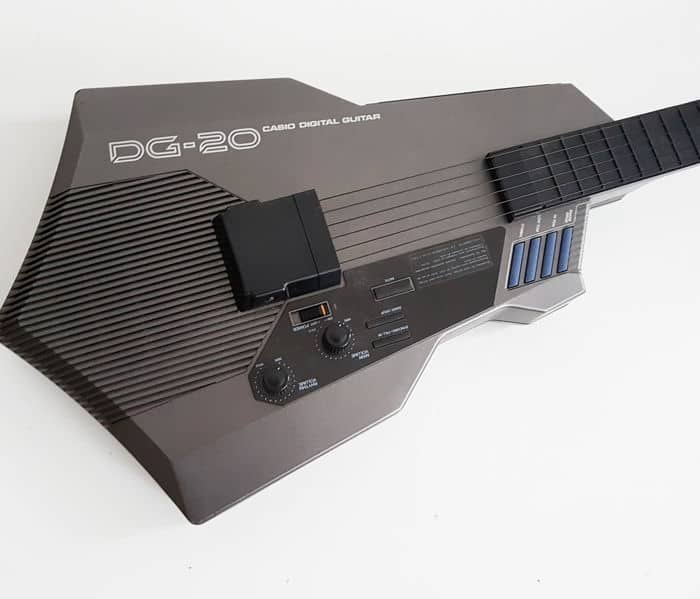
Let’s be honest, synth guitars never really took off.
Perhaps the most well-known piece in this category is the Casio DG-20 that stormed the music scene in the late 80s.
This synth guitar featured a disposition pretty similar to regular guitars, but with incredibly futuristic looks.
Its nylon strings feel like regular guitar ones, but not quite. They are actually all the same gauge of a classical guitar nylon B string.
When you play a note, there’s little to no acoustic sound. Sounds are produced by an integrated synth that uses info from the sensor on the strings to determine which pitch is being played.
A clever concept, but something most musicians never adopted and stayed with traditional keyboard synths.
The synth guitar concept was reiterated after this shifting from actual guitars to effect pedals and everything in between.
What music genres can be played with a synth guitar
Synth guitars can be a staple of modern music. Of course synthwave, 80s pop, and any other kind of music deeply driven by electronic instruments will be a style where they could shine.
Are synth guitars good for beginners?
Synth guitars can be rather complex to work with, especially because of their electronic/digital side.
These are more probably a fun instrument for intermediate to experienced players to play with when they are looking to expand their sound palette.
How do synth guitars sound?
Synth guitars can sound like many things. They are just a way of sending pitch information to a synthesizer. But think of digital modern sounds popularized in the 80s but still used on many songs.
You can check out their sound here:
Players that use synth guitars
Some of the most popular synth guitar players ever, in no particular order, are:
- John Abercrombie
- Jan Akkerman
- Jeff Baxter
- Adrian Belew
- Matt Bellamy
What is the best type of guitar for you?
Deciding what type of guitar is the best for you shouldn’t be something to stress about.
The easiest way to arrive at a conclusion is by looking at what your favorite players are playing.
Are they rocking on solid body electrics, semi-hollows, or maybe they mostly play acoustics?
There is no good enough reason to pick up a type of guitar that’s not the one you intend on playing down the road.
I say this because it was very common, at least until a few years ago, to recommend beginners to start on an acoustic, even when they wanted to play the heaviest of metal genres.
Is there a benefit to learning the nuances of different types of guitars? Absolutely!
But why delay what you really want?
I can assure you, you can learn the instrument in whatever of its forms, there are not necessarily harder or easier ones, each has its pros and cons.
Something to consider, however, is that some kinds of guitars are cheaper than others.
Namely, the most popular types, such as acoustics and solid body electrics, will be available at lower price points for entry-level players.
Common questions about types of guitars
Finally, here are some answers to many of the most frequently asked questions about different types of guitars.
What are the most common types of guitars?
The most common types of guitars are electric, solid, semi-hollow body, acoustic and classical. Bass guitars are also very popular, of course, and traditional folk types of guitars tend to be very popular in their original countries.
What is the easiest type of guitar to learn?
Many teachers recommend their students start with an acoustic guitar, because of its simplicity, however, electric guitars, particularly solid body ones, can be easier on the hands, and if ultimately your goal is to play electric, there’s no real good reason to start your journey with any other kind of guitar.
What is the best type of guitar for a beginner?
The best type of guitar for a beginner is the type of guitar he or she intends to play long-term. There’s no point in starting out with a guitar type different from the one you really like. Each kind of guitar has its pros and cons, and with all of them, you will get to learn the basics in a few months.
What is the most affordable type of guitar?
You can find acoustic and classical guitars for as low as $150, or even lower. There are also entry-level solid body electric guitars at a similar price point, however, to play an electric guitar properly you will also need to get a cable and an amp which can easily double the initial budget required.
Can you switch from one type of guitar to another easily?
Switching from one guitar type to another is, in most cases, an easy thing to do. They are all guitars after all. Of course, certain kinds of guitars have particular nuances and techniques you will need to develop, but the general knowledge is completely translatable.
For instance, if you learned with an acoustic, and then jump to an electric guitar, at first it will take some getting used to the slight difference in size and feel. After that, clean sounds will sound like home.
Now, if you turn on some distortion, it might take you a while to get used to having to mute every string you are not playing constantly to avoid unwanted noise.
I think, however, you will pick it up way faster than if you haven’t ever played any other type of guitar before.
What differentiates guitar types?
The differences between guitar types are varied and generally focus on certain aspects that set a category of instruments apart from the other.
You could easily find ways of categorizing guitars where certain types will end within the same group, while if you define them by other aspects they will be considered of a different set.
As an example, think of classical and acoustic guitars: If you were to define them by how they produce their sound, you could say that both rely upon acoustic resonance and consider them of the same type.
Now, if, for instance, you try to group them by the kind of strings they use, you will end up with 2 different species.
And I know there are some acoustic guitars that use nylon strings, but before you write me an angry letter, this was just an example.
Ultimately, what sets guitar types apart from each other is what you or, the general culture defines as a unique enough character that some have and others don’t.
How many strings do most guitar types have?
Most guitars have 6 strings, although you can also find them with 7, 8, 9, or even more for extended-range guitars. 12-string guitars have double courses where higher pairs are tuned in unison and lower ones in octaves.
Are there any guitars with less than 6 strings?
You could find custom guitars made with less than 6 strings, although they are not common. Bass guitars, however, usually have 4 strings but are also common in 5 and 6-string versions.
What are 4-string guitars called?
Guitars with 4 strings, in most cases, are bass guitars. These are instruments that achieve lower pitches and have thicker strings and longer necks than regular guitars.

Hello there, my name is Ramiro and I’ve been playing guitar for almost 20 years. I’m obsessed with everything gear-related and I thought it might be worth sharing it. From guitars, pedals, amps, and synths to studio gear and production tips, I hope you find what I post here useful, and I’ll try my best to keep it entertaining also.

